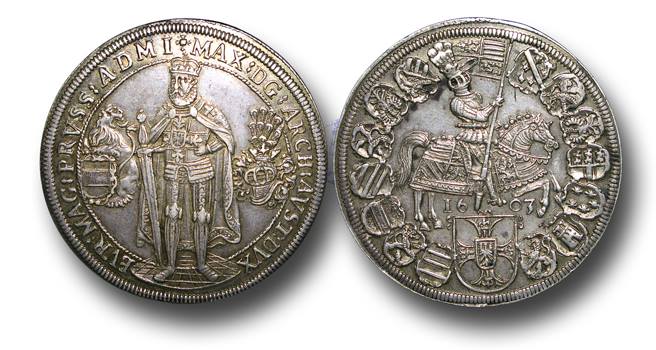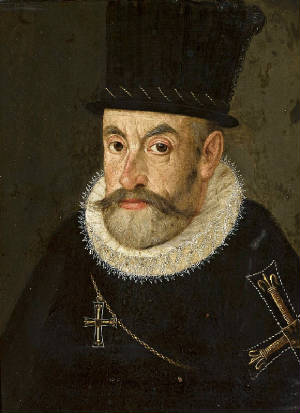Maximilian
III of Austria, also known as Maximilian the Grand Master of the Teutonic Knights (12 October 1558 –
2 November 1618) was the Archduke of Further Austria from 1612 until his death. Born in Wiener Neustadt, Maximilian was the fourth son of the emperor Maximilian II
and Maria of Spain. He was a grandson of Anna of Bohemia and Hungary, daughter and heiress
of Vladislaus II of Bohemia and Hungary, who himself was the eldest son of Casimir IV of Poland
from the Jagiellonian Dynasty. From 1585
Maximilian became the Grandmaster of the Teutonic
Order; thanks to this he was known by the epithet der Deutschmeister ("the German Master") for
much of his later life.

In 1587 Maximilian stood as a candidate for the throne of Polish-Lithuanian
Commonwealth, following the death of the previous king, Stefan Batory. A portion of the Polish nobility elected Maximilian
king, but, as a result of the rather chaotic nature of the election process, another candidate, Sigismund III Vasa, prince
of Sweden, grandson of Sigismund I the Old, was also elected. Maximilian attempted to resolve the dispute by bringing a military
force to Poland – thereby starting the war of the Polish Succession. His cause had considerable support in Poland,
but fewer Poles flocked to his army than to that of his rival. After a failed attempt to storm Kraków in late 1587,
he was defeated in January 1588, at Pitschen in Silesia (Battle of Byczyna) by the supporters of Sigismund III (who had since
been formally crowned), under the command of Polish hetman Jan Zamojski. Maximilian was taken captive at the battle and was
only released a year and half later after the intervention of Pope Sixtus V in the aftermath of the Treaty of Bytom and Będzin.
In 1589, he formally renounced his claim to the Polish crown. The inactivity of his brother, the emperor Rudolf II, Holy
Roman Emperor in this matter contributed to Rudolf's poor reputation.

From 1593 to 1595 Maximilian served as regent for his young cousin, Ferdinand,
Archduke of Inner Austria. In 1595 he succeeded their uncle Ferdinand II, Archduke of Further Austria in his territories,
including Tyrol, where he proved to be a solid proponent of the Counter-Reformation. He also worked to depose Melchior Khlesl,
and to ensure that Archduke Ferdinand of Inner Austria, his former charge, succeed as Holy Roman Emperor. Today, Maximilian is perhaps best remembered for his baroque archducal hat, exhibited in the treasury of the monastery of Klosterneuburg
and was used for ceremonial purposes as late as 1835. He died at Vienna in 1618, and is buried in the canopied tomb in Innsbruck Cathedral.
